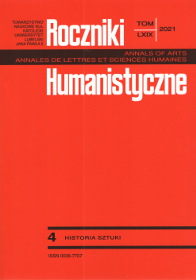Tapestries from the Dowry of Queen Bona Sforza d’Aragona
Abstract
Queen Bona Sforza d’Aragona, who came to the Kingdom of Poland from Bari in Italy in 1518, brought a handsome dowry, as described by Giuliano Passero. Among the large number of expensive items were tapestries – the “panni di razza”, which was a series of eight tapestries portraying the Works of Mercy and four door curtains (portieres). The aim of this article is to supplement the current knowledge about these tapestries by drawing conclusions from studies by Italian authors on the subject matter and their new interpretations, which were previously unknown in Polish literature. Based upon all currently available source information, namely works by Giuliano Passero, Colantonio Carmignano, Antonio Beatillo, Giovanni Battista Pacichelli and Giulio Petroni, we can infer that Bona donated four of the eight tapestries from the Works of Mercy, which had been made with great mastery, to the Basilica of Saint Nicholas in Bari, probably because she considered the church to be a suitable place to preserve them. She also chose this particular church because she had a special devotion to its saint. The tapestries were placed in the basilica between 1520 and 1557. These fabrics were probably in the Bari church’s collection until the end of the 17th century. Presumably, this series, as well as Bona’s four portieres, have not survived to this day.
References
„Arazzo”. Dizionario italiano, www.grandidizionari.it/Dizionario_ Italiano/parola/a/ arazzo.aspx? query=arazzo. Dostęp 5.11.2020
Barycz, Henryk. „Bona Sforza, regina di Polonia”. Dizionario Biografico degli Italiani, vol. 11 (1969). Treccani, www.treccani.it/enciclopedia/bona-sforza-regina-di-polonia_(Dizionario- Biografico)/. Dostęp 5.11.2020
Bender, Agnieszka. Tapiserie w dawnej Rzeczypospolitej. Wydawnictwo KUL, 2004.
Bender, Agnieszka. „Bona Sforza d’Aragona i rola mody w kształtowaniu jej wizerunku”. Fabrica Litterarum Polono-Italica, nr 1 (2), 2020, ss. 33-52.
Bogucka, Maria. Bona Sforza, wyd. II, Ossolineum, 2004.
Botana, Federico. The Works of Mercy in Italian Medieval Art (c.1050-c.1400). Brepols, 2011.
Campbell, Thomas P., Maryan Wynn Ainsworth, Rotraud Bauer, Pascal-François Bertrand, Iain Buchanan, Elizabeth Cleland, Guy Delmarcel, Nello Forti Grazzini, Maria Hennel-Bernasikowa, Lorraine Karafel, Lucia Meoni, Cecilia Paredes, Hillie Smit, i Andrea Stockhammer. Tapestry in the Renaissance: Art and Magnificence. Metropolitan Museum of Art, 2002.
Chruszczyńska, Jadwiga, i Ewa Orlińska-Mianowska. Tkaniny dekoracyjne. Przewodnik dla kolekcjonerów. Arkady, 2009.
Cioffari, Gerardo. „Bona Sforza. Aspetti religiosi ed umanitari della sua personalità”. La regina Bona Sforza tra Puglia e Polonia: Atti del Convegno promosso dall’Associazione culturale Regina Bona Sforza sotto il patrocinio della Regione Puglia, della Provincia, del Comune e dell'Università di Bari: Bari, Castello Svevo, 27 aprile 1980, red. Bronisław Biliński i Jerzy Burchardt, Zakład Narodowy im. Ossolińskich, 1987, ss. 62-106.
Cioffari, Gerardo. Bona Sforza. Donna del Rinascimento. Tra Italia e Polonia. Levante, 2000.
Forti Grazzini, Nello. „Flemish Weavers in Italy in the Sixteen Century”. Flemish Tapestry Weavers Abroad. Emigration and the Founding of Manufactories in Europe: Proceedings of the International Conference, Mechelen, October 2–3, 2000, red. Guy Delmarcel, (Symbolae Series B, 27), Leuven University Press, 2002, ss. 131-161.
Genaille, Robert. Słownik malarstwa holenderskiego i flamandzkiego. Tłum. Ewa Maliszewska i Krystyna Secomska, Wydawnictwa Artystyczne i Filmowe, 1975, s. 134.
Ghidoli, Luigia Maria. „Arazzo”. Enciclopedia Italiana (1935). Treccani, www.treccani.it/enci clopedia/arazzo_%28Enciclopedia-dell%27-Arte-Medievale%29/. Dostęp 5.11.2020.
Hennel-Bernasikowa, Maria. „Arrasy królowej Bony/Gli arazzi Della Regina Bona”. Bona Sforza. Regina di Polonia e duchesa di Bari. Catalogo della mostra. Parte 1, red. Maria Stella Calò Mariani i Giuseppe Dibenedetto, Nuova Comunicazione, 2000.
Malaguzzi Valeri, Francesco. La corte di Lodovico il Moro. Le arti industriali la letteratura la musica. U. Hoepli, 1923 (reprint: Forgotten Books, 2018).
Meijer, Emile. Les Trésors du Rijksmuseum Amsterdam. Edition Scala – Philip Wilson, 1985.
„Meester van de Levensbron”. RKD Images, rkd.nl/en/explore/images/record?query=acts+of+ mercy&start=41 dostęp 5.11.2020.
„Meester van Sint Goedele”. RKD Images, rkd.nl/en/explore/images/record?query=acts+of+mercy &start=84. Dostęp 5.11.2020.
Passera, Claudio. „Un incunabulo per lo sposalizio di Isabella d’Aragona: Le Nuptiae Illustrissimi Ducis Mediolani di Stefano Dolcino (1489)”. Drammaturgia, t. 14, nr 4, 2017, ss. 305-326.
Petroni, Giulio. Della storia di Bari dagli antichi tempi sino allo’anno 1856, t. 1, Napoli 1857 (reprint: Nabu Press, 2011).
„Regione siciliana assessorato dei beni culturali e dell’identitá siciliana”. Dipartimento Beni Culturali ed Ambientali e dell’Identitá Siciliana. Soprintendenza BB.CC.AA di Trapani FSC 2014-2020 „Patto per la Sicilia”, www.regione.sicilia.it/beniculturali/soprintp/SBCA_Trapani/ amministrazione_trasparente/11_doc_gare-contratti/2019_08_05_pubbl_avviso_manut_ straord_arazzi/relazione_tecnica_manut_straord_arazzi.pdf. Dostęp 5.11.2020.
Seremak, Waldemar. „Uczynki miłosierdzia”. Encyklopedia katolicka, t. 19, TN KUL, 2013, kol. 1284-1285.
„The Seven Works of Mercy: A Medieval Morality”. ReedDesign, reeddesign.co.uk/paintedchurch/ seven-works-of-mercy.htm. Dostęp 5.11.2020.
Tosi, Luigia Maria. „Portiera”. Enciclopedia Italiana (1935). Treccani, www.treccani.it/enciclo pedia/portiera_%28Enciclopedia-Italiana%29/. Dostęp 5.11.2020.
Van Bühren, Ralf. „Caravaggio’s Seven Works of Mercy in Naples. The relevance of art history to cultural journalism”. Church, Communication and Culture, t. 2, nr 1, 2017, ss. 63-87. doi: 10.1080/23753234.2017.1287283.
Copyright (c) 2021 Roczniki Humanistyczne

This work is licensed under a Creative Commons Attribution-NonCommercial-NoDerivatives 4.0 International License.





